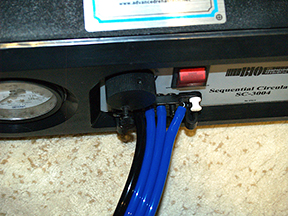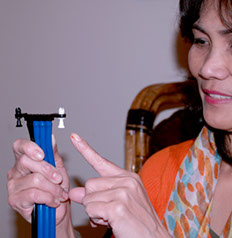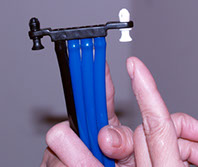
Amy's page. A Certified Lymphedema Therapist's thoughts on Lymphedema
Meticulous skin and nail care is imperative for lymphedema patients to minimize the risk of
infection. Patients with lymphedema are at a higher risk of developing infections due to
weakened skins barriers and lymphatic system. The most common infection is cellulitis.
Cellulitis a bacterial infection that occurs when streptococcus and/or staphylococcus
enter the skin throw a small opening. Listed below are tips can be utilized to lower the risk
of infection.
- Cleanse, dry and moisturize skin daily. Use a low pH or pH balanced lotion (fragrance free)
- Ensure that garments, shoes and clothing fit properly
- Perform daily skin inspections. Use adaptive equipment if needed. A skin inspection mirror can be fabricated with a magnifying mirror, dowel rod and duct tape.
- Use bug spray
- Avoid hot water
- Utilize UV protection clothing
- Use an electric razor
- Wear gloves when gardening or performing other outdoor work.
- Cleanse and treat cuts, abrasions, or insect bites immediately. Monitor closely for infection.
- Seek nail care from podiatrist or professional, if possible.
- Avoid injections or vaccinations in the affected extremities. In the event of a medical
emergency this may not be possible.
Patients who have developed lymphedema can and should be active. Over the
years, after thousands of patient, we have
seen that it is very easy to fall into a sedimentary lifestyle. The more you sit around the bigger
you will get. Those
who never exercised before should consider starting that daily walk, swim or spending twenty minutes
on a stationary
bicycle. The right type of physical activity helps to reduce the swelling by improving the flow of
lymph, and presents a
vital tool for patients to stay in shape and continue with normal activities of daily living.
Many patients ask if they can continue their pre-lymphedema activities, or if
they should adjust, or replace them. The
answer to that question depends on the kind of activity. Tennis or golf for example does not rank
very high on the list
of beneficial activities for individuals with upper extremity lymphedema. For patients with
lymphedema of the leg,
activities that damage the leg should be avoided. Any activity that can cause a break in the skin
should stopped.
Wearing your compression garment during these physical activities in important. Along with an
exercise regimen does not
cause discomfort or pain. It is fine to continue with these activities.
However, if the affected limb hurts, feels strained, or increases in volume
during and after the activity, the patient
should adjust as necessary and consult with their lymphedema therapist or physician. The keywords
here are caution and
moderation; gradual progression is imperative while trying to accomplish an improved return of
lymphatic fluid without
adding further stress to an impaired lymphatic system.
Aerobic conditioning is generally performed in a repetitive fashion using large muscle groups. Some
long-term benefits
include decrease in resting heart rate, improved muscular strength, weight control and increased
return of venous and
lymphatic fluids.
It is important to understand that certain aerobic exercises and recreational activities could
trigger an increase in
swelling, or contain higher risks of injury. Ideally, such high-risk activities should be avoided by
patients suffering
from lymphedema. Examples of these high-risk activities include soccer, kick-boxing or step-aerobics
for lower extremity
lymphedema, and tennis/racquet or golf for lymphedema affecting the arms.
Beneficial activities for upper and lower extremity lymphedema include (but are not limited to):
Swimming/water aerobics – with the body weight reduced by about 90% in chest-deep water, exercises
performed in the
water improves mobility and enhances strength and muscle tone. In addition, the pressure exerted by
the water on the
body surface contributes to lymphatic and venous return. Hot water (temperature above 94 degrees F)
usually found in hot
tubs and Jacuzzis must be avoided. High water temperature definitely has a negative impact on
lymphedema
Walking – a 20-minute walk outdoors, or on a treadmill (10-15 minutes, slow walking speed) while
wearing the compression
garment, will stimulate the circulatory system and contribute greatly to the individual’s general
well-being. Key
points: walk with a normal gait; do not drag the affected leg and avoid limping
Easy Biking – 25-20 minutes either outdoors or at the gym, using a comfortable and wide saddle. Legs
are placed in a
higher position on recumbent bikes, which makes them a better choice for individuals affected by
lower extremity
lymphedema
Yoga – the combination of stretching, deep breathing, relaxation and the positive impact on the
venous and lymphatic
return, makes yoga a perfect choice of exercise. Strenuous yoga practices should be avoided, and if
certain poses seem
uncomfortable, they should be altered, or skipped. Many cancer centers and support groups have
contacts for yoga classes
specifically tailored to cancer survivors and lymphedema patient
In general, exercises and activities should always be performed with the compression garment in
place; intensity and
duration of any exercise should be gradually increased; movements that over-strain, cause discomfort
or pain should be
avoided, and the extremity should be carefully monitored for any changes in size or shape.
Getting coverage for a Lymphedema
Pump has been getting harder every year. In order to make it easier
for yourself,
there are some things to remember. Insurance companies, including Medicare look at the Clinical
Records of the
prescribing doctor. So, it is very important to make sure that all the issues you have with
Lymphedema are in his notes
for your condition. Most insurance companies follow Medicare guidelines for getting a pump. One of
the biggest things
that Medicare wants to see is your use of a compression stockings or wraps. It is crucial that the
doctor have notes
concerning use of a compression stocking. Even if you can't use one for what ever reason, your
records need to show that
it was tried. Even if the notes say that you tried and failed with a stocking, that will help.
Without it, your
equipment could be denied
From the publication JAMA Dermatol 2015, "Patients with lymphedema may reduce their risk of
cellulitis, as well as the
number of outpatient visits, by using an advanced pneumatic compression device (APCD), according to
a new study.
"Our study demonstrates, for the first time, that receipt of an advanced pneumatic compression
device is associated with
significant improvements in key clinical endpoints for lymphedema patients, both for those with
cancer and those
without," Dr. Pinar Karaca-Mandic of the University of Minnesota School of Public Health in
Minneapolis told Reuters
Health by email.
"This finding has important implications for the patients who suffer from the disease, especially
for those who have
high rates of cellulitis. These devices serve as a viable self-management option and can reduce the
need for more
intensive outpatient care in rehabilitative settings," she added.
Advanced devices have more garment chambers and greater adjustability than earlier devices, the
researchers wrote."

We are always getting calls about the boots / sleeves not feeling up with air.
Usually, the main problem is that the
connector bar has become dislodged because there was tension on the bar. It is an easy fix.
Just
squeeze the ends and
push it back on to the pump.

Sometimes the hose will come off the nipple, the hose can be pushed back on
sometimes and it will work fine. If you
cannot get the hose on the nipple again or the nipple itself has snapped off, we have a fix
for that. A replacement
connector bar. The hoses can be cut off the old connector bar and placed on the new
connector bar. We can walk you threw
the process if necessary. Just call for the connector bar kit, and or advice.




